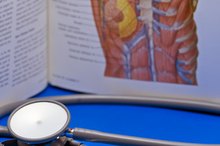What does fact checked mean?
At Healthfully, we strive to deliver objective content that is accurate and up-to-date. Our team periodically reviews articles in order to ensure content quality. The sources cited below consist of evidence from peer-reviewed journals, prominent medical organizations, academic associations, and government data.
- Gut and Liver: Epidemiology of Gallbladder Disease -- Cholelithiasis and Cancer
- Gut and Liver: Epidemiology of Gallbladder Disease -- Cholelithiasis and Cancer
- Gastroenterology: Gallstone Disease Is Associated With Increased Mortality in the United States
- Gastroenterology: Gallstone Disease Is Associated With Increased Mortality in the United States
The information contained on this site is for informational purposes only, and should not be used as a substitute for the advice of a professional health care provider. Please check with the appropriate physician regarding health questions and concerns. Although we strive to deliver accurate and up-to-date information, no guarantee to that effect is made.
Irritable Bowel vs. Gallstones
Abdominal discomfort is one of the most common reasons people seek medical care. Irritable bowel syndrome and gallbladder disease are frequently diagnosed in patients who have abdominal pain. According to a 2005 "American Family Physician" review, IBS affects 10 to 15 percent of the U.S. population 1.
A 2012 report in "Gut and Liver" indicates that up to 15 percent of American adults eventually develop gallstones. Although the symptoms of IBS and gallstones may overlap, these conditions can usually be differentiated.
Symptoms
Gallstone pain typically begins an hour or so after a meal, rapidly increases in intensity, plateaus and lasts for roughly 1 to 6 hours before subsiding. Gallstones frequently awaken patients at night. Nausea and vomiting are common during an "attack."
Gallstone pain is severe and is usually located in the right upper part of your abdomen. However, it can radiate to your back or right shoulder blade area. A change in bowel habits is not a prominent symptom of gallstones.
Abdominal pain due to IBS is typically not located in any particular region of your abdomen, although it can be.
The discomfort caused by IBS tends to be crampy and less severe than gallstone pain, and people with IBS usually aren’t awakened by it. IBS may be triggered by foods, stress or anxiety. One of the hallmarks of IBS is a change in bowel habits -- constipation, diarrhea or both. Bloating, belching and intolerance to fatty foods are more common in IBS than in people with gallstones, but these symptoms can occur with both conditions.
- Gallstone pain typically begins an hour or so after a meal, rapidly increases in intensity, plateaus and lasts for roughly 1 to 6 hours before subsiding.
- The discomfort caused by IBS tends to be crampy and less severe than gallstone pain, and people with IBS usually aren’t awakened by it.
Diagnosis
Elevated Liver Enzymes & IBS
Learn More
Gallstones are readily diagnosed using imaging procedures that visualize your gallbladder. Abdominal ultrasound is most commonly used for detecting gallstones. However, people without gallstones can develop gallbladder inflammation and pain, too. In such cases an ultrasound will not reveal gallstones, although your symptoms may suggest that you have them.
People with IBS often go through an array of diagnostic tests to identify the cause of their symptoms.
In fact, IBS is a "diagnosis of exclusion," meaning all other mechanical, biochemical and inflammatory causes of your symptoms must be ruled out before a diagnosis of IBS can be made. Abdominal ultrasound, upper endoscopy, colonoscopy, stool analysis and blood tests could be part of the workup for people with IBS.
- Gallstones are readily diagnosed using imaging procedures that visualize your gallbladder.
- In such cases an ultrasound will not reveal gallstones, although your symptoms may suggest that you have them.
Treatment
Approximately 80 percent of people with gallstones never have symptoms and, therefore, do not require treatment.
Once your gallstones start causing pain, however, your symptoms may escalate until medical intervention -- usually surgery -- is required to bring relief. Once gallstones become symptomatic, delaying treatment could lead to serious complications, such as pancreatitis, an inflammation of the pancreas.
IBS usually responds to medications that relieve bowel spasms, diarrhea or constipation. Dietary modifications, probiotics and antidepressants may also be useful.
People whose symptoms are triggered by anxiety or stress sometimes benefit from psychotherapy. Your doctor will tailor your treatment to address your predominant symptoms.
- Approximately 80 percent of people with gallstones never have symptoms and, therefore, do not require treatment.
Long-Term Course
Appendicitis Symptoms in Women
Learn More
Many people with gallstones are unaware of their presence until they undergo an abdominal ultrasound, CT or x-ray for other reasons.
Their long-term health may not be substantially affected by their gallstones. However, a study published in the February 2011 issue of "Gastroenterology" suggests that people with gallstones are at increased risk for heart disease, cancer and early death, possibly due to factors that increase their risk for all of these conditions, such as obesity and diabetes 4. Removing the gallstones does not alter this risk.
IBS symptoms tend to wax and wane, and your condition may cause persistent or intermittent discomfort for years. IBS is not a life-threatening condition but it may adversely affect your quality of life.
- Many people with gallstones are unaware of their presence until they undergo an abdominal ultrasound, CT or x-ray for other reasons.
Related Articles
References
- American Family Physician: Treatment of Irritable Bowel Syndrome
- Gut and Liver: Epidemiology of Gallbladder Disease -- Cholelithiasis and Cancer
- Merck Manual for Health Care Professionals: Cholelithiasis
- Gastroenterology: Gallstone Disease Is Associated With Increased Mortality in the United States
- Stinton LM, Shaffer EA. Epidemiology of gallbladder disease: cholelithiasis and cancer. Gut Liver. 2012;6(2):172–187. doi:10.5009/gnl.2012.6.2.172
- Njeze GE. Gallstones. Niger J Surg. 2013;19(2):49–55. doi:10.4103/1117-6806.119236
- Johnson CD. ABC of the upper gastrointestinal tract. Upper abdominal pain: Gall bladder. BMJ. 2001;323(7322):1170–1173. doi:10.1136/bmj.323.7322.1170
- Baiu I, Hawn MT. Gallstones and Biliary Colic. JAMA. 2018;320(15):1612. doi:10.1001/jama.2018.11868
- Complications of gallstones. InformedHealth.org. Updated February 8, 2017.
- Vitale GC. Early management of acute gallstone pancreatitis. Ann Surg. 2007;245(1):18–19. doi:10.1097/01.sla.0000250967.32581.c9
- Recio-Boiles A, Waheed A, Babiker HM. Cancer, Gallbladder. StatPearls Publishing. Updated May 18, 2019.
- Lee JY, Keane MG, Pereira S. Diagnosis and Treatment of Gallstone Disease . Practitioner . June 2015;259(1783):15-9, 2.
- Mayo Clinic Staff. Gallstones . Mayo Clinic. November 17, 2017.
- National Institute of Diabetes and Digestive and Kidney Diseases. Gallstones . National Institutes of Health. U.S. Department of Health and Human Services. November 2017.
Writer Bio
Stephen Christensen started writing health-related articles in 1976 and his work has appeared in diverse publications including professional journals, “Birds and Blooms” magazine, poetry anthologies and children's books. He received his medical degree from the University of Utah School of Medicine and completed a three-year residency in family medicine at McKay-Dee Hospital Center in Ogden, Utah.









